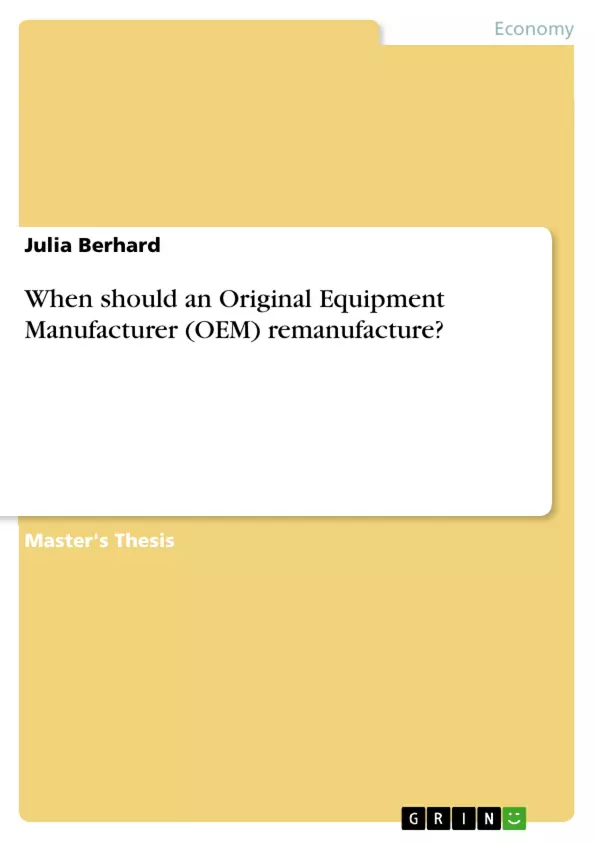An increasing rate of return, raw material prices and carbon emissions urge companies to look for sustainable solutions. The value of returned products can be recaptured through closed-loop supply chain activities and in particular through reconditioning, of which remanufacturing is one option that retains a high value. The definition must be clear, however, as the term is not yet common. This recovery type ensures that a restored product fulfils an equivalent or even superior function than the original product. Furthermore, it receives the same warranty as a new product and secures profits while minimizing the environmental impact.
When a company decides whether remanufacturing is a viable option, several factors have to be considered. Therefore, the aim of this thesis was to provide guidance for the remanufacturing decision, while bridging the gap between research and practice. An extensive literature review provided general remanufacturing benefits and issues, as well as a selection of the most important influencing characteristics. Subsequently, hypotheses were formulated per characteristic category, which were product, internal and external, and tested via surveys and statistically. The analysis yielded that a product should be highly modular, have a long product life cycle and a residual value. The internal processes require sufficient return quantities as a starting point, low processing costs compared to the original production and the processing time has to be weighed against other benefits. In addition, a market demand has to be established and the cannibalization effect should be taken into account. Finally, a positive perception of remanufactured products and sufficient market channels to commercialize them are favourable for remanufacturing. Using the survey means of the influencing characteristics a ranking was created, irrespective of the signs, but with regard to the strength. The top five are processing costs, residual value, customer perception, product life cycle and processing time. These rankings are slightly different depending on the industry. Lastly, interviews with experts further supplemented the analysis and a managerial framework was created to provide guidance for the remanufacturing decision process.
Table of Contents
- 1. Introduction.
- 2. Literature Review..
- 2.1. Theoretical Background..
- 2.1.1. Reverse Logistics and Closed-Loop Supply Chains
- 2.1.2. Definitions Remanufacturing, Returns and OEM.
- 2.1.3. Remanufacturing Benefits.
- 2.1.4. Remanufacturing Issues
- 2.2. Characteristics Influencing the Remanufacturing Decision.
- 2.2.1. Product Characteristics..
- 2.2.2. Internal Characteristics.
- 2.2.3. External Characteristics..
- 2.3. Conceptual Framework and Relevance.
- 2.1. Theoretical Background..
- 3. Methodology..
- 3.1. Research Approach
- 3.2. Survey Design ........
- 3.3. Data Collection and Sample Descriptives..
- 4. Analysis
- 4.1. General Returns Management and Recovery Options.
- 4.2. Remanufacturing and Influencing Factors (Hypothesis Testing)
- 4.3. Ranking and Summary of Influencing Characteristics
- 4.4. Insights from Practitioners (Cases and Interviews)
- 4.4.1. Industrial Production Case: Production and Quality Assurance Staff.
- 4.4.2. Automotive Case: Remanufacturing Specialists....
- 5. Discussion
- 6. Conclusion......
- 7. Managerial Implications.
- 8. Limitations & Future Research
Objectives and Key Themes
This master thesis aims to provide guidance for Original Equipment Manufacturers (OEMs) in making decisions about remanufacturing. It bridges the gap between research and practice by identifying key factors influencing the remanufacturing decision. The thesis explores the benefits and issues associated with remanufacturing, examines the characteristics of products, internal processes, and external environments that affect remanufacturing feasibility, and analyzes data from surveys and interviews with industry experts to develop a framework for making informed remanufacturing decisions.
- The benefits and challenges of remanufacturing.
- The influence of product, internal, and external characteristics on remanufacturing decisions.
- The development of a managerial framework to guide remanufacturing decisions.
- The analysis of industry case studies and expert interviews.
- The identification of key factors influencing remanufacturing decisions.
Chapter Summaries
Chapter 1 introduces the concept of remanufacturing and its importance in closing the loop in supply chains. It highlights the growing trend of product returns and the need for sustainable solutions. Chapter 2 provides a comprehensive literature review on remanufacturing, including its theoretical background, benefits, issues, and the key characteristics influencing remanufacturing decisions. Chapter 3 outlines the methodology employed in the thesis, including the research approach, survey design, and data collection methods. Chapter 4 presents the analysis of the data, including the general returns management and recovery options, the testing of hypotheses about influencing factors, and the ranking and summary of those factors. Finally, Chapter 4 also includes insights from practitioners through case studies and interviews with industry experts. The concluding chapter discusses the findings, managerial implications, limitations of the research, and potential avenues for future research.
Keywords
This master thesis focuses on the following key concepts and topics: remanufacturing, closed-loop supply chain, reverse logistics, product returns, sustainable solutions, influencing characteristics, managerial framework, industry case studies, expert interviews.
- Citation du texte
- Julia Berhard (Auteur), 2015, When should an Original Equipment Manufacturer (OEM) remanufacture?, Munich, GRIN Verlag, https://www.grin.com/document/310103



